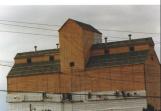1
Bentley's first elevator - Alberta Pacific Grain Company1918
Bentley, Alberta
 Credits:
Credits:Bentley Museum Society
9
Older United Grain Growers elevator gets torn down2000's
Bentley, Alberta
 Credits:
Credits:Bentley Museum Society
11
Last remaining elevator in Bentley - Now privately owned2005
Bentley, Alberta
 Credits:
Credits:Bentley Museum Society
12
BENTLEY ELEVATORSThe Lacombe and Northwestern Railway Line (the "Peanut" Line) was completed in 1919 and ran from Lacombe through Bentley, Rimbey and on to Bluffton. Following its completion, elevators began to appear along the line.
In 1918, Bentley got its first elevator, built by Alberta Pacific Grain Company. This first elevator was operated by Tom Lorimer. It is said that during that first year there would be loads lined up as far back as the Blindman River waiting to unload at the elevator.
In 1919, the Imperial Oil Company opened a warehouse beside the track. Thomas Lorimer was also the agent for this operation and was kept quite busy handling both grain and oil business for the area.
A few years later, the Alberta Pacific Grain Company built a house on 48th Avenue for the elevator agent. The Lorimers were the first residents. The family moved to Lacombe in 1925.
Bill Pringle was the next manager of the Alberta Pacific Grain Company. He was followed by Tony Tharou and then Henry Tharou. This elevator was eventually taken over by the Alberta Wheat Pool.
The second elevator was built in 1920. This facility was sold to the Alberta Wheat Pool in 1928. The United Grain Growers would not have another elevator in Bentley for thirty-five years.
Jim Thompson was the first buyer at this second elevator, followed by Fred Hunter and then Art Hallonquist. While Art was the elevator agent, the elevator was struck by lightning and destroyed by fire. The Alberta Wheat Pool replaced this elevator. When Art retired, he was replaced by Jim Fink, then John Somshor and finally Ernie Spannier.
The Wheat Pool owned houses located on 48 Avenue and 50 Avenue. The Pool eventually sold their company houses to their employees, Ernie Spanner and Bill Brown.
Following a company study in 1962, the United Grain Growers decided to centralize and build an elevator in Bentley. The facilities at Aspen Beach, Forshee and Prevo were closed. The Aspen Beach and Prevo elevators were torn down in 1963 and some of the materials were used to build a new elevator in Bentley. Andy Bartko became the elevator agent for United Grain Growers in Bentley followed by Mr. White and Alvin Freeman.
This latest elevator had a capacity of 70, 000 bushels. An annex was added in 1967 which held another 100, 000 bushels of grain. Stan Beddoes became the manager for United Grain Growers in Bentley in 1967. During his time as elevator agent there were many changes in agricultural methods. His business expanded to include fertilizer and chemicals. Stan remained as the manager of this elevator until he retired in 1993.
In 1976 the two Wheat Pool elevators were completely destroyed by fire. It was only due to the heroic effort on the part of Stan Beddoes, Phillip Butcher, Brian Lenz and Myles Wasik that the UGG elevator was not also destroyed. These four individuals were on top of the UGG elevator putting out all the hot spots that could have ignited the whole elevator. The Red Deer and Sylvan Lake Fire Departments also assisted.
These two older elevators that were lost in the fire, were replaced by one larger, more modern Wheat Pool elevator which was operated by Ernie Spannier. After Ernie's death, Brian Wittal managed the Alberta Wheat Pool elevator.
In the late 1990's, the United Grain Growers took over the Wheat Pool elevator and for awhile they operated two elevators in Bentley. When Stan Beddoes retired, he was replaced by Doug Brosz. All three of the last elevator agents were assisted by Phillip Butcher. The older UGG elevator was torn down.
The one remaining elevator, now operated by United Grain Growers, continued to operate for a number of years. The Alberta Wheat Pool and United Grain Growers eventually amalgamated and became Agricore United. When Agricore United built an island terminal along the railway east of Lacombe, the elevator in Bentley closed. This elevator is still standing but is privately owned. It still says Alberta Wheat Pool on the elevator, but was actually owned by UGG for a few years before it closed.
One area on the east side of the last elevator has been painted white. This is the screen for drive-in movies, which are held on special occasions. The movie is projected on the elevator, and you listen to the sound over a radio station in your car.
The last elevator to operate in Bentley, originally built by the Alberta Wheat Pool, then later owned by United Grain Growers, and finally by Agricore United was quite an up-to-date elevator. There was a basement underneath the office where the furnace, a shower, and computer components were located. The keyboard and monitor were upstairs in the office, but due to the large size of the other components, they were housed in the basement. This computer was among one of the first computers in Bentley. Stan Beddoes had to go to Winnipeg for a computer course in 1986, so he could operate the computer and in that way keep in touch with the head offices in Winnipeg and Calgary.
On long winter days the elevator was always a good place to go for a cup of coffee. You would probably run into a few friends and could exchange some good stories. You might even get in on a game of cards. We hear "Pitch" was one of the favorites.
The hours for an elevator agent could be quite long during the fall when harvesting was in full swing. Often an agent would be at the elevator until ten or eleven o'clock at night, and of course, was open for business on Saturday and Sunday too.
Stan Beddoes says he often stopped to see local farmers on his way home in the evening. He could ride around the field with the farmer and look at the grain. Stan carried portable grain testers with him. He usually brought along a couple of beer to share with the farmer. I am sure after a long day this was appreciated by both Stan and the farmer.
Hi-jinks were not unheard of around the elevator either. One time a crew was doing some repair work at the elevator, and they happened to here that Stan had a pretty good throwing arm. They bet Stan a case of beer that he could not throw a softball over the top of the elevator. It cost that crew a case of beer and Stan had a sore arm for quite a few days.
Around Christmas time, Stan always had a "good will afternoon" at the elevator. The afternoon of course ran into the evening. On quite a few occasions this get together just happened to fall on the same evening as a local Christmas concert. Some dads ended up being a little late for their children's concert - or worse yet, never made it at all.
One summer day at the UGG things were fairly quiet and a bumble bee came to call. Stan caught it, put it in a box and had it couriered to one of the girls in the head office in Calgary. Nice Surprise!
The prairie elevator brings back many memories. There were always lots of sparrows flying and hopping about, picking up the spilled grain. It was a dirty, noisy place, but it appealed to us all. The farmers were always chatting with the elevator agent, discussing crops, the weather and such things as dockage, bushels-per-acre and moisture content.
Elevators in Alberta are gradually disappearing. At one time, more than 1,700 wooden grain elevators were operating in Alberta and now there are probably fewer than 200 left. In some towns, they still stand and have been designated as historic sites or have been converted into museums. About a century ago, many crews moved from town to town building elevators and now they move from town to town demolishing them. As each elevator falls, it changes the landscape of the prairies and leaves one feeling a bit dismal as part of our heritage is lost.
Our skylines are no longer dotted with a vertical element- that of the country grain elevator. The transportation and grain industry have been consolidating their business in an effort to cut costs to remain competitive. The result is the construction of large capacity inland terminals. Big changes came in the 1990's - deregulation of the railways, the demise of the Crow rate and a move by the grain companies to position themselves globally led to the construction of these large inland terminals. Their capacity of handling 52- car trains means that the terminals have to be built far beyond town limits. I guess this is what they call "progress" but to the citizens or most folks in Bentley this is rather sad. We miss the familiar design and location, known as "elevator row". These elevators blended so well into our community.







